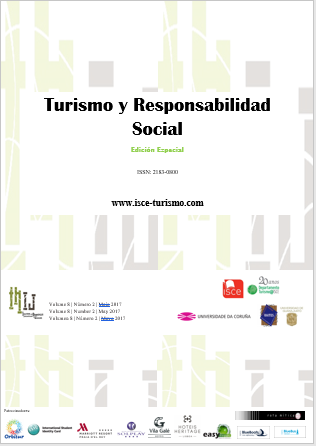Patrimônio imaterial e suas possíveis relações com o turismo: Um estudo sobre o grupo cultural Boi Flor do Lírio de Parnaíba, Piauí, Brasil
DOI:
https://doi.org/10.57883/thij8(2)2017.30375Palabras clave:
Parnaíba, Patrimonio inmaterial, Identidad, Bumba-meu-Boi, TurismoResumen
Bumba-meu-boi es una fiesta de carácter artístico y cultural que se realiza en todo Brasil, revelando así características diversificadas de la cultura popular. Considerada patrimonio inmaterial reconocido por el Instituto del Patrimonio Histórico y Artístico Nacional, forma parte de la identidad de un pueblo. El objeto de estudio de este artículo es el grupo folclórico de bumba-meu-boi "Boi Flor do Lírio", del distrito de São José, en la ciudad de Parnaíba, estado de Piauí. Pretende describir la historia del grupo cultural Flor do Lírio, identificando las actividades realizadas por el grupo y señalando las dificultades que impregnan el mantenimiento de esta manifestación popular, al tiempo que refleja el potencial del bumba-meu-boi como atractivo turístico. Se trata de una investigación cualitativa, bibliográfica, documental y descriptiva. Entre los principales resultados, está que el grupo entiende el bumba-meu-boi como su identidad cultural, destacando la importancia de mantener las actividades para transmitirlas a las generaciones futuras. También reconoce la importancia del turismo como vector de difusión del grupo y ayuda a la preservación de la memoria.
Citas
Arantes, A. A. (1999). O que é cultura popular. São Paulo: Brasiliense.
Barbosa, E. L. (2006). Valeu boi!: O negócio da vaquejada. Teresina: Edufpi.
Bardin, L. (1977). Análise de conteúdo. Lisboa: Edições 70.
Barreto, M. (2001). Manual de iniciação ao estudo do turismo. Papirus Editora.
Batista, C. M. (2005). Memória e identidade: Aspectos relevantes para o desenvolvimento do turismo cultural. Caderno Virtual de Turismo, 5(3), 27-33.
Bolle, W. (2003). Patrimônio cultural e identidades. São Paulo: Roca.
Canclini, N. (1999). A globalização imaginada. São Paulo: Iluminuras.
Carvalho, K. D. (2011). Lugar de memória e políticas públicas de preservação do
patrimônio: Interfaces com o turismo cultural. Bahia.
Cascudo, L. C. (1984). Vaqueiros e cantadores. São Paulo: Ed. da USP.
Commelin, P. (2011). Mitologia grega e romana. São Paulo: WMF.
Costa, F. R. (2009). Turismo e patrimônio cultural. São Paulo: SENAC.
Dias, R. (2006). Turismo e patrimônio cultural: recursos que acompanham o crescimento das cidades. São Paulo: Saraiva.
Gil, A. C. (2008) Métodos e técnicas de pesquisa social (6ª. ed.). São Paulo: Atlas.
Hall, S. (2006). A identidade cultural na pós-modernidade. Rio de Janeiro: DP&A.
Ibge. Censo 2010. Retirado de http://ibge.gov.br (2016.01.24; 16h30).
Iphan. (2011) Dossiê do registro do Complexo Cultural do Bumba-meu-boi do Maranhão. Retirado de http://portal.iphan.gov.br (2015.12.20; 11h).
Kauark, F. S., Manhães, F. C & Medeiros, C. H. (2010). Metodologia da pesquisa: guia prático. Itabuna: Via Litterarum.
Lakatos, E. M. & Marconi, M. A. (2003). Fundamentos de metodologia científica (5ª. ed.). São Paulo: Atlas.
Le Goff, J. (1996). História e memória (3ª.ed.). Campinas: Unicamp.
Leite, J. D. A. (2003). Um teatro da morte: Transfiguração poética do bumba-meu-boi e desvelamento sociocultural na dramaturgia de Joaquim Cardozo. Recife: Fundação de Cultura Cidade.
Mendes, J. A. (2009). Estudos do património: Museus e educação. Coimbra: Imprensa
da Universidade de Coimbra.
Meneses, J. N. C. (2006). História & turismo cultural. Belo Horizonte: Autêntica.
Neves, B. A. de C. (2003). Patrimônio cultural e identidades. In C. Martins, Turismo,
cultura e identidade. São Paulo: Roca.
Pedrazani, V. (2010). No “miolo” da festa: Um estudo sobre o bumba-meu-boi do Piauí.
Tese de Doutorado em História Social apresentada na Universidade Federal Fluminense, Instituto de Ciências Humanas e Filosofia.
Pedroso. S. F. (1999). A carga cultural compartilhada: A passagem para a interculturalidade no ensino de português língua estrangeira. Dissertação de Mestrado apresentada na Universidade Estadual de Campinas.
Pereira, J. B. B. (1981). Estudos antropológicos e sociológicos sobre o negro no Brasil.
Aspectos históricos e tendências atuais. In Contribuições à Antropologia em homenagem ao professor Egon Schaden. 4. São Paulo: Universidade de São Paulo, 193-206.
Pereira da Costa, F. A. (1974). Folk-Lore pernambucano. Recife: Arquivo Público
Estadual.
Porto, C. E. (1975). Roteiro do Piauí. Teresina: COMEPI.
Santana, A. (2009). Antropologia y turismo. Barcelona: Ariel.
Santos, J. L. (2005). O que é cultura. São Paulo: Brasiliense.
Silva, K. V. & Silva, M. H. (2006). Dicionário de conceitos históricos. São Paulo: Contexto.
Sousa, B. J. (1958). Ciclo do carro de bois no Brasil. São Paulo: Companhia Editora Nacional.
Unesco. Patrimônio cultural no Brasil. Retirado de http://www.unesco.org (2015.12.21; 13h43).
Wehling, A. (2003). As estratégias da memória social. Brasilis: Revista de História Sem
Fronteiras. Rio de Janeiro: Editora Atlântida.
Descargas
Publicado
Cómo citar
Número
Sección
Licencia
Derechos de autor 2017 Tourism and Hospitality International Journal is licensed under a Creative Commons License - Attribution 4.0 International.

Esta obra está bajo una licencia internacional Creative Commons Atribución 4.0.
Este trabalho encontra-se publicado com a Licença Internacional Creative Commons Atribuição 4.0.






